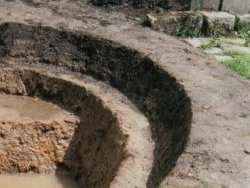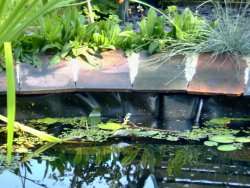Features: Ponds |  |
A creative method of hiding a pond liner
After you've created a pond in your garden, the last thing you want to look at is the pond liner. So what can you do if the water level drops and exposes it? Here's one habitat-enhancing solution.
The problem This picture of the pond hole, taken during construction, clearly shows the steep sides above the planting shelf where the liner would later be exposed when water levels dropped.
When I created a new pond in my garden during the summer of 2002, I wanted one that would be a haven for wildlife, but it also had to work within the available space and conform to my overall design aspirations for the garden. I opted for a semi-formal pond design which included some steep sides (see the feature on creating a wildlife-friendly pond). This picture of the pond hole, taken during construction, clearly shows the steep sides above the planting shelf where the liner would later be exposed when water levels dropped.
When I created a new pond in my garden during the summer of 2002, I wanted one that would be a haven for wildlife, but it also had to work within the available space and conform to my overall design aspirations for the garden. I opted for a semi-formal pond design which included some steep sides (see the feature on creating a wildlife-friendly pond).  Where the pond has steep sides, placing a soil substrate over the liner is not an option Where the pond has steep sides, placing a soil substrate over the liner is not an option Where the pond has steep sides, placing a soil substrate over the liner is not an option and if the water-level drops, as it frequently did during the hot summer weather of 2003, the pond liner can become exposed. Where the pond has steep sides, placing a soil substrate over the liner is not an option and if the water-level drops, as it frequently did during the hot summer weather of 2003, the pond liner can become exposed.
The exposed liner at the pond edge is a problem in at least three ways:
- it looks ugly;
- it exposes the liner to potential damage from the sun's ultra-violet radiation;
- on steep edges, it exacerbates an already difficult exit from the pond for many animals.
 Here you can see how the liner becomes exposed when water levels drop in the pond. Here you can see how the liner becomes exposed when water levels drop in the pond. Refilling the pond with tap water is not the answer Refilling the pond with tap water is not the answer Refilling the pond with tap water is not the answer because the nitrates in the tap water can upset the water chemistry, quite likely resulting in an algal bloom (see, for example, the feature on combating algae with barley straw). I needed another approach. Refilling the pond with tap water is not the answer because the nitrates in the tap water can upset the water chemistry, quite likely resulting in an algal bloom (see, for example, the feature on combating algae with barley straw). I needed another approach.
The solution
At one end of the pond, the sides are shallower and more gently shelving and here I have created a stone 'beach'. At this end I was able to bank the stones up at the edge to hide the exposed liner, but this was not possible elsewhere. The problem areas around the steeper sides consist of an almost vertical side about 30cm in height around a planting shelf.
 I considered the option of making sure that I had a spread of marginal plants all around the planting shelf in order to hide the liner I considered the option of making sure that I had a spread of marginal plants all around the planting shelf in order to hide the liner I considered the option of making sure that I had a spread of marginal plants all around the planting shelf in order to hide the liner. In the long term, this would be a nice solution but to do it quickly would require a large number of plants and would be expensive. I started to think along the lines of covering the liner with something inert; but what? Trawling around my local garden centre I found various 'natural' screening solutions which are designed, principally, for covering unsightly boundaries like old fences and so on. One of them, marketed as 'brushwood screening', looked to me as though it might do the trick. I considered the option of making sure that I had a spread of marginal plants all around the planting shelf in order to hide the liner. In the long term, this would be a nice solution but to do it quickly would require a large number of plants and would be expensive. I started to think along the lines of covering the liner with something inert; but what? Trawling around my local garden centre I found various 'natural' screening solutions which are designed, principally, for covering unsightly boundaries like old fences and so on. One of them, marketed as 'brushwood screening', looked to me as though it might do the trick.
Although it can be obtained in smaller sizes, the only size available in the garden centre at the time was 5*2 metres; rather larger than I required! However, since I have some other jobs it can help me with, I bought one of these large screens.  The screen appears to be made principally from dried heather bound by intertwined wires The screen appears to be made principally from dried heather bound by intertwined wires The screen appears to be made principally from dried heather bound by intertwined wires. I used secateurs to cut 30cm wide strips of the screening. Each of these strips of screening remained securely bound by two pairs of the intertwined wires. The 30cm dimension is significant because one edge of the strip rests on the planting shelf while the other is tucked nicely under the overhanging roof tiles which surround the pond. This close fit, together with some judiciously placed stones and planting containers, ensure that the screening is held nicely against the side of the pond above the planting shelf. The screen appears to be made principally from dried heather bound by intertwined wires. I used secateurs to cut 30cm wide strips of the screening. Each of these strips of screening remained securely bound by two pairs of the intertwined wires. The 30cm dimension is significant because one edge of the strip rests on the planting shelf while the other is tucked nicely under the overhanging roof tiles which surround the pond. This close fit, together with some judiciously placed stones and planting containers, ensure that the screening is held nicely against the side of the pond above the planting shelf.
The final solution?
I was very pleased with the results: its solves all three problems presented by the exposed liner:
- it looks good;
- it protects the liner from the sun's ultra-violet radiation;
- it provides and excellent means of exit from the pond for many animals.
A further benefit which I didn't really consider before selecting the brushwood is that
- it substantially enriches the habitat at the pond edge.
 The extra structural dimension added by the brushwood itself and the relatively protected spaces which occur between the brushwood and the liner will benefit many animals which inhabit the pond The extra structural dimension added by the brushwood itself and the relatively protected spaces which occur between the brushwood and the liner will benefit many animals which inhabit the pond The extra structural dimension added by the brushwood itself and the relatively protected spaces which occur between the brushwood and the liner will benefit many animals which inhabit the pond. In light of what has been discovered about the possible inhibiting effects of wood/bark on pond algae (see the feature on combating algae with barley straw) it is even possible that the brushwood could help in this respect. The extra structural dimension added by the brushwood itself and the relatively protected spaces which occur between the brushwood and the liner will benefit many animals which inhabit the pond. In light of what has been discovered about the possible inhibiting effects of wood/bark on pond algae (see the feature on combating algae with barley straw) it is even possible that the brushwood could help in this respect.
 It remains to be seen how the brushwood fares over time It remains to be seen how the brushwood fares over time It remains to be seen how the brushwood fares over time. No doubt the wires holding it all together will rust and begin to disintegrate, but we shall have to see how long that takes. And only time will tell how the brushwood fares after prolonged exposure to water and, in winter, the freezing and thawing of the pond surface. For now at least, the brushwood is proving to be a relatively cheap and very effective solution to the problems posed by a bare liner. It remains to be seen how the brushwood fares over time. No doubt the wires holding it all together will rust and begin to disintegrate, but we shall have to see how long that takes. And only time will tell how the brushwood fares after prolonged exposure to water and, in winter, the freezing and thawing of the pond surface. For now at least, the brushwood is proving to be a relatively cheap and very effective solution to the problems posed by a bare liner.
| First published August 2003. | |
Copyright Richard Burkmar 2003. Permission is hereby granted for anyone to use this article for non-commercial purposes which are of benefit to the natural environment as long the original author is credited. School pupils, students, teachers and educators are invited to use the article freely. Use for commercial purposes is prohibited unless permission is obtained from the copyright holder. |
Back to home page
Do you live in Merseyside? Interested in its wildlife? |